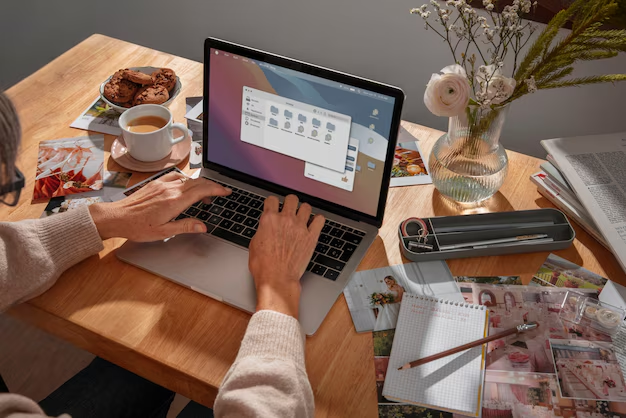1. Introduction
In an era shaped by digital-first consumer behaviors, a high-performing website is more than just a corporate accessory—it’s the cornerstone of your brand presence. Whether you’re a local bakery expanding online or a tech startup going global, your website can serve as a 24/7 sales representative—if it’s built to engage, convert, and scale. And that’s exactly what happened for one of Nveil’s clients, who saw an impressive 200% jump in online sales.
Nveil is a design agency specializing in creating websites that fuse aesthetics, marketing strategy, robust development, and ready-made solutions for small to medium-sized businesses (SMBs). This case study reveals how a stagnating local business broke free from flat sales to secure remarkable growth by integrating brand-focused design, funnel alignment, technical excellence, and a laser-sharp SEO approach. We’ll explore:
• The initial hurdles that kept them stuck
• How aligning the website with the client awareness funnel delivered transformative results
• Specific tactics in branding, UX, search visibility, and conversion optimization
• The role of high-competition and moderate-competition keywords in boosting search rankings on Google, Bing, Yahoo, and Yandex
By following this real-world example, SMB owners can see the potential for genuine, sustained increases in leads and sales when design, marketing, development, and SEO are thoughtfully combined.
2. Initial Challenges: A Snapshot of the Local Business
2.1 The Client: “Greenwood Interiors”
• Type of Business: A local furniture and home decor store aiming to expand into e-commerce
• Existing Website: Outdated design, minimal branding, no clear CTAs
• Online Presence: Inconsistent social media, near-zero SEO, no mailing list
• Revenue Stagnation: Physical store sales stayed flat, and online revenue contributed less than 5% of total sales
2.2 Key Pain Points
• Design Obsolescence: A decade-old site that no longer met users’ modern design expectations
• Low Visibility: Virtually invisible on SERPs for critical keywords (e.g., “affordable website solutions,” “local furniture store”)
• High Bounce Rates: Visitors who landed on the site quickly left, lacking trust or clarity
• No Sales Funnel Strategy: No forms or targeted content to guide potential buyers to checkout
Greenwood Interiors had a strong offline brand—renowned locally for quality craftsmanship—but couldn’t convert that reputation into online revenue.
3. Unaware & Problem-Aware: Identifying the Real Issues
Greenwood Interiors found themselves in the Problem-Aware category: They sensed the site wasn’t generating sales but didn’t know the root cause or potential solutions. Suspecting design and a lack of SEO were issues, they sought an expert analysis to confirm and guide them forward.
3.1 Breaking Down the Core Problems
• Lack of Brand Cohesion: The site’s bland aesthetic contradicted the store’s rustic-modern vibe, confusing customers
• Technical Constraints: No real-time inventory, minimal e-commerce functionality, archaic CMS
• No Analytics: Zero data on user behavior or site performance hampered any improvement efforts
• No Lead Capture: Missing pop-up forms, newsletter sign-up, or design consultation CTAs
3.2 Nveil’s Initial Assessment
Nveil quickly recognized that Greenwood Interiors needed a thorough redesign, not a band-aid fix. A brand-aligned visual overhaul, funnel-based marketing, upgraded technical foundation, and SEO best practices were essential. The SMB was intrigued, progressing from Problem-Aware to seeking a meaningful strategy—our job was to guide them further into the Solution-Aware phase.
4. Solution-Aware: Nveil’s Approach to Overcoming These Challenges
Greenwood Interiors realized they needed a holistic transformation—addressing design, marketing, and development simultaneously. Nveil proposed a cohesive roadmap, promising synergy between brand identity, funnel logic, SEO, and robust site performance.
4.1 Design: Creating a User-Friendly, Brand-Focused Experience
• Brand Audit: Slight logo tweaks to maintain heritage feel, establishing a palette of warm earth tones echoing their store ambiance
• Site Layout & Navigation: Hero banners showcasing curated interiors; intuitive category pages (“Living Room,” “Bedroom,” “Outdoor”) with large product images
• Responsive & Accessible: Ensured design was mobile-friendly, sub-2-second load times, and compliance with alt texts/high contrast for usability
4.2 Marketing: Mapping the Funnel and Strategic Content
• Funnel-Focused Strategy: TOFU blog posts (“Why Quality Furniture Matters”), MOFU case studies (“How Our Custom Pieces Elevated X Client’s Home”), BOFU discount offers or free design consultations
• Lead Magnets: E-book “Choosing the Right Furniture for Your Space,” gated by an email form
• Keyword Integration: High-competition (“SEO services,” “web design agency,” “digital marketing company”) plus moderate-competition (“ready-made websites for small businesses,” “conversion optimization tips”)
• Social Proof & Testimonials: Embedded Google Reviews, short videos showcasing local satisfied clients
4.3 Development: Building a Scalable, High-Performance Base
• Platform Choice: WordPress/WooCommerce to manage real-time inventory, variants, coupon codes
• Clean Codebase: Minified scripts, caching, CDN usage, ensuring quick loads
• Security Layers: SSL certificates, daily backups, firewall configurations
• User-Centric Features: One-page checkout, integrated chatbot, advanced filtering on product listings
5. Product-Aware & Most Aware: Implementing the Strategy
Greenwood Interiors fully embraced Nveil’s recommended transformations. They opted for a semi-custom route—combining a specialized furniture/decor template with brand-specific modifications, advanced e-commerce modules, and thorough SEO structure.
5.1 Ready-Made Website Solutions vs. Full Custom
A semi-custom approach saved time and budget while retaining enough flexibility to stand out. This ensured they didn’t spend months on a purely bespoke project but still got a distinctive look.
5.2 SEO and Keyword Strategy
• High-Competition: “SEO services,” “web design agency,” “digital marketing company,” “responsive design” (featured in relevant blog mentions or site sections)
• Moderate-Competition: “Ready-made websites for small businesses,” “affordable website solutions,” “local SEO strategies” (targeted in meta tags, blog posts, product pages)
• Long-Tail: “How to choose rustic modern furniture,” “Best eco-friendly home decor in [City Name]”
5.3 UX Enhancements and Conversion Optimization
• Cross-Selling: “Recommended for You” and “You May Also Like” on product pages
• Cart Recovery Emails: Automated reminders for abandoned carts
• Pop-up Offers: Time-delayed subscription form offering 10% off first purchase
6. Results: Tracking the Path to 200% Growth in Online Sales
With the new site live, Greenwood Interiors saw their investment pay off quickly:
6.1 Major Wins
• 200% Surge in online sales within four months
• Organic Traffic up by 60% thanks to better on-page SEO and consistent blog updates
• Average Order Value (AOV) jumped 25%, credited to cross-sells and improved brand trust
• Newsletter Sign-Ups grew 5x, fueled by the e-book lead magnet
6.2 Key Metrics
• Conversion Rate: Rose from 1.2% to 3.8%
• Time on Page: Doubled from 45 seconds to ~1 min 30 secs
• Returning Visitors: Increased from 10% to 30%, reflecting stronger brand loyalty
6.3 Funnel Alignment in Action
TOFU: Blog posts and infographics captured new interest, “soft selling” the brand.
MOFU: E-books, case studies, and interactive “Room Decor Quiz” nurtured visitors further.
BOFU: Pricing details, discount codes, and trust signals closed deals—explaining the remarkable sales jump.
7. Common Pitfalls and How Nveil Avoided Them
Pitfall #1: Focusing Only on Aesthetics
Nveil’s Fix: Integrated a marketing and SEO roadmap, ensuring visuals served funnel goals.
Pitfall #2: Underestimating Mobile or Accessibility
Nveil’s Fix: Thorough responsive testing, alt-text for images, color contrast compliance for inclusive design.
Pitfall #3: Ignoring Analytics
Nveil’s Fix: Deployed Google Analytics, Search Console, and heatmaps—using data to fine-tune CTAs, product pages, or lead forms.
Pitfall #4: No Content Strategy
Nveil’s Fix: Created a content calendar targeting moderate-competition keywords and funnel-stage topics.
Pitfall #5: Neglecting Post-Launch Optimization
Nveil’s Fix: Ongoing support, monthly site audits, iterative improvements based on analytics.
8. Funnel Alignment: Ensuring the Right Content for Each Awareness Stage
Greenwood Interiors exemplifies how funnel alignment produces big gains in leads and sales. Each page or CTA was mapped to funnel stages—ensuring Unaware/Problem-Aware visitors found relevant, educational content while Most Aware leads saw frictionless checkout and compelling discount offers.
9. Conclusion: A Testament to Holistic Design, Marketing, and Development
Greenwood Interiors’ story underscores the power of integrated design, marketing, and development in propelling SMBs to new sales heights. By combining brand-centric visuals, robust e-commerce features, a funnel-focused marketing plan, and strategic SEO, the brand soared from minimal online revenue to an astounding 200% increase in just four months.
At Nveil, we champion this holistic methodology—creating sites that aren’t just visually impressive, but also built to capture leads and close sales across the buyer journey. We balance high-competition keywords (like “web design agency”) with moderate-competition terms (“ready-made websites for small businesses”), ensuring your site remains visible and relevant in the face of fierce competition on Google, Bing, Yahoo, and Yandex.
If you’re an SMB owner looking to revitalize or build a new website that genuinely impacts your bottom line, consider a similar blueprint—one that prioritizes brand identity, funnel alignment, performance, and ongoing optimization. This case study proves your online presence can evolve from an afterthought into a dynamic sales engine, affirming that doubling—or even tripling—your online sales is well within reach when every aspect of design, marketing, and development clicks into place.



